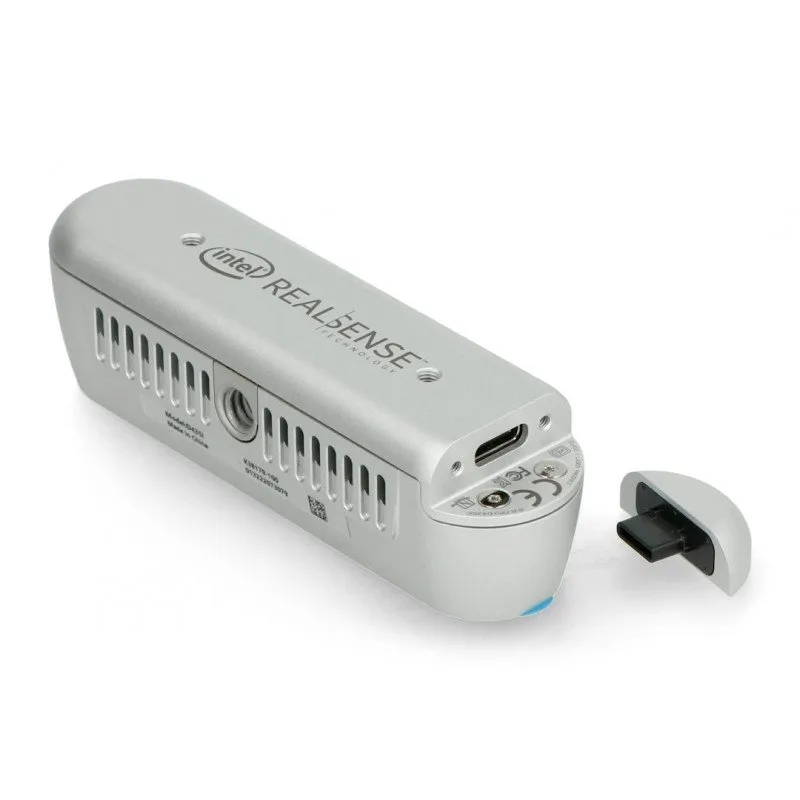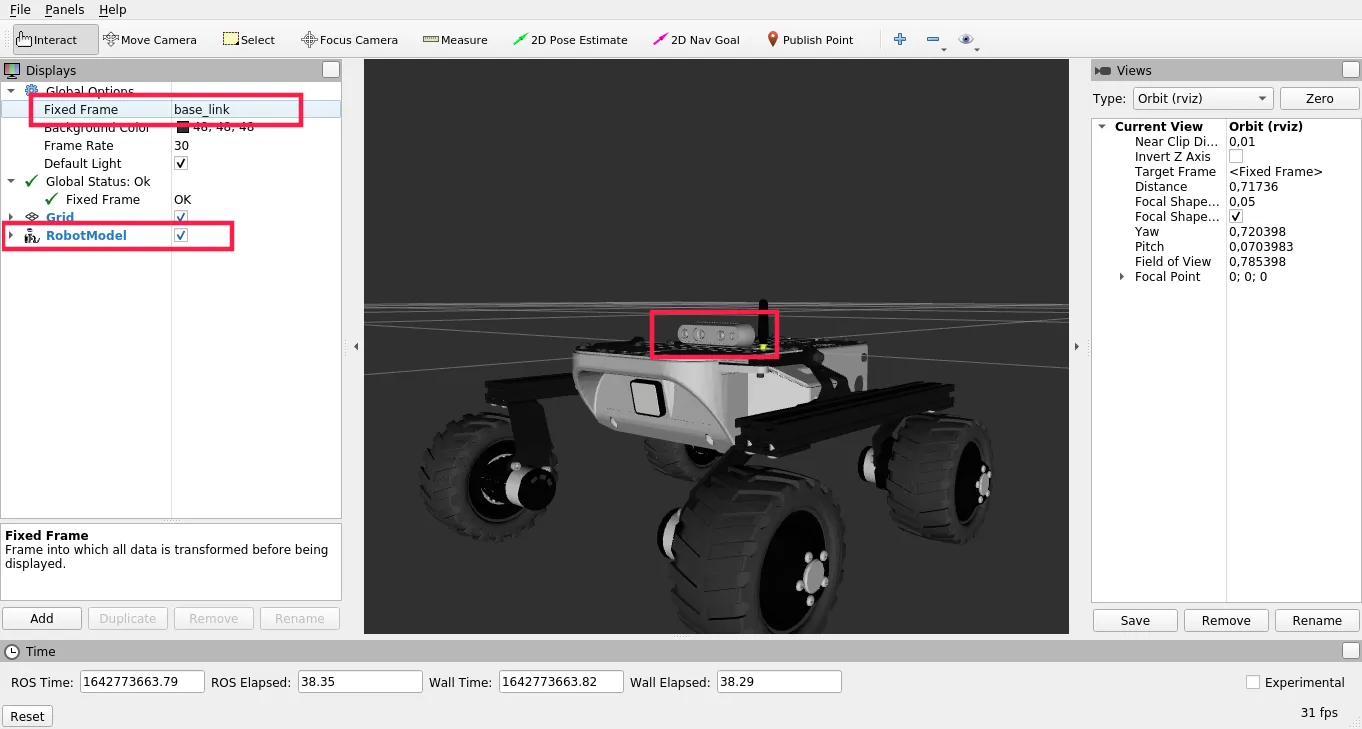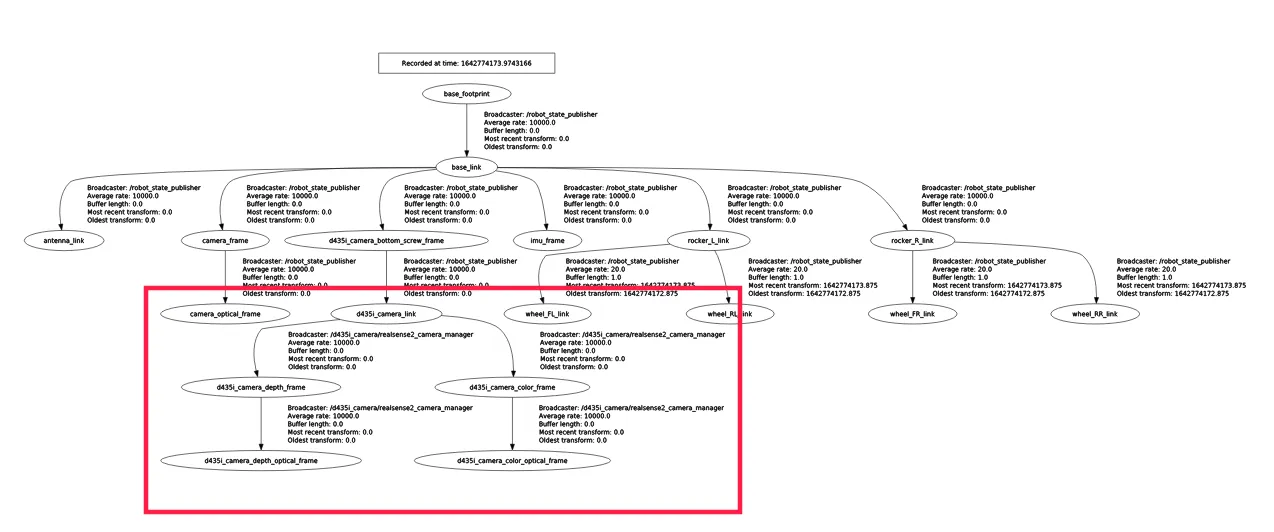Intel RealSense Camera Integration
In this tutorial we will present the process of connecting a RealSense camera to your Leo Rover and integrating it with the system on Intel RealSense D435i example.
Intel RealSense stereo camera is a type of camera capable of capturing image from two points at the same time. Using stereo disparity - the difference in object location as seen by the left and right lenses - cameras like Intel RealSense are capable of distinguishing the distance of objects from the camera. This data can then be used to in a wide array of cases. In robotics, stereo cameras are commonly used for mapping the environment, object recognition, 3D scanning and in many other.
What to expect?
Having finished the tutorial you will possess basic knowledge about the use of stereo cameras with ROS.
Prerequisites
Mechanical integration
RealSense cameras provide two mounting mechanisms:
- One 1/4-20 UNC thread mounting point.
- Two M3 thread mounting points.
You can use those mechanisms, or print a special plate, and attach camera to it, and then mount the plate to the Rover.
Wiring and electronics connection
For connecting the camera to your Rover you can use USB-C cable, as RealSense has USB-C 3.1 Gen 1 connector. You need to remove special plate on the back side of the camera, which covers the USB port, and you are ready to connect the camera through the USB port on the Rover.

Software integration
Installing the packages
As ROS realsense2_camera package is available as a debian package, we will
install it using apt. To do so, connect to the rover via ssh, and type:
sudo apt install ros-${ROS_DISTRO}-realsense2-camera
We want also the description package, which includes 3D models of the device (those are required for some nodes). To install them type in the terminal:
sudo apt install ros-${ROS_DISTRO}-realsense2-description
The version of librealsense2 is almost always behind the one available in RealSense™ official repository, but this way is much easier to install. If you want to install the newest version, you can follow this tutorial.
Adding camera model
As we would like to have the robot aware of where the camera is, we need to
create an URDF file with the RealSense included. On
this
site you can see which urdf camera models are available in the
realsense2_description package. Each of the files there has a xacro macro
with a lot of properties. We need to include the correct macro to make the
camera visible with the robot's model.
<?xml version="1.0"?>
<robot xmlns:xacro="http://www.ros.org/wiki/xacro">
<xacro:include filename="$(find realsense2_description)/urdf/_d435i.urdf.xacro"/>
<xacro:sensor_d435i parent="base_link" name="d435i_camera">
<origin xyz="0.132 0 0.0102" rpy="0 0.0872 0"/>
</xacro:sensor_d435i>
</robot>
You can specify name property to anything you want. We just need to change it,
so we don't have conflicts on camera_link tf frame. origin property is for
specifying the position of the camera regarding the link specified in parent
property. So if the parent property is set to "base_link", the position in
origin property is regarding the origin of the Rover.
If you are not using our mounting adapter you might have to change the values in
origin property.
Now we have to include our camera model in robot.urdf.xacro file - the
description that is uploaded at boot. Add this line somewhere before the closing
</robot> tag.
<xacro:include filename="/etc/ros/urdf/realsense.urdf.xacro"/>
Launching camera nodes on system startup
To get the image from camera, you need to launch the camera nodes. You can simply do it by typing in terminal those commands
source /opt/ros/${ROS_DISTRO}/setup.bash
ros2 launch realsense2_camera rs_launch.py camera_name:=d435i_camera camera_namespace:=/
You need to specify the camera_name argument because of the tf frame
conflicts. You have to put the same value as in the urdf file. We set here the
camera_namespace argument for convenience - default value for it is "camera",
which is the same as the robot's default camera. Therefore setting the argument
to empty string will automatically put the node's topics into global namespace.
We can create a launch file that would start the node with a fitting configuration.
<launch>
<include file="$(find-pkg-share realsense2_camera)/launch/rs_launch.py">
<arg name="camera_namespace" value=""/>
<arg name="camera_name" value="d435i_camera"/>
</include>
</launch>
Make sure to specify the camera_name argument to the right value. You need
that for working camera model in visualization.
You can check what other options you can specify directly in the file by running in terminal
ros2 launch realsense2_camera rs_launch.py -s
Include the launch file in the robot.launch.xml file somewhere before the
closing </launch> tag, so that the node starts at boot.
<include file="/etc/ros/realsense.launch.xml"/>
Now, the realsense camera node will be launched with every system startup. You can also force this start right now with
ros-nodes-restart
Examples
Reading and visualizing the data
The topics from camera node should be now visible. You can check them with
ros2 topic tool - topics from your node will have prefix and namespace
specified by you in the camera and camera_namespace ROS arguments.
If you have ROS installed on your computer, you can get the camera image with
rqt, and see the robot model with camera attached using rviz2.
In rqt go to plugins -> visualization choose image view and then
choose your topic.
Don't worry if the quality is low, and the image is lagging. It is due to transfer of the data through your rover and computer.
You can also start RViz, and add robot model in the display view. Choose
also base_link as fixed frame, and you should see the rover model with
camera attached.

You can also display tf tree in rqt, to see if everything is configured
correctly (plugins -> visualization -> TF Tree)

What next?
Stereo cameras are commonly used in projects involving autonomous navigation, you might be interested in a tutorial about it.
They are however, not the only way of teaching a Leo Rover how to move on it's own. Check out our line follower tutorial if you want to learn more. You can also check our Integrations page for more instructions.